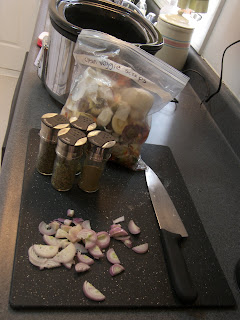Changed. My. World.
Now, I probably get that bag out of the freezer twice a day to contribute some scraps and the bag was full in about two weeks. My first attempt at achieving a flavorful vegetable stock was a success, and waaaay too easy! I love to use stock as a low-fat and no-sugar way to flavor grains by substituting stock for water and butter or oil.
For good measure, I sauteed some shallots in olive oil beforehand just in case, added my cheapskate version of a bouquet garni (tossed in dried marjoram, rosemary, thyme, bay leaf without the cheesecloth), 8 peppercorns, and enough water to cover the vegetables.

The first bag contained:
- Tomato stems and cores
- Red pepper stems, seeds, and that white stuff on the ribs
- Butternut squash skins
- Outer layers of onions, garlic, shallots
- Avocado pit
After 8 hours,
 I pulled the solids from the pot, pushed the water out of them using a colander,
I pulled the solids from the pot, pushed the water out of them using a colander, and had a delicious stock. Be sure to cool it down quickly before putting it in the fridge or freezer! I use freezer packs and a few ice cubes.
and had a delicious stock. Be sure to cool it down quickly before putting it in the fridge or freezer! I use freezer packs and a few ice cubes.
When saving scraps, DO include:
- Onion peels (will give it a darker color)
- Garlic ends
- Stems of leafy greens
- Carrot tops and greens
- Apple and pear cores
- Stems of fresh herbs
- Turnip and parsnip peelings
- Bitter or waxy plant parts, such as cucumber peels, stone fruit pits, or citrus peels (oops! I had an avocado pit in there, but it seemed to do no harm)
- Potatoes (they do not freeze well)
- Anything moldy
I have two questions for readers:
- Have you ever used beet trimmings in your stock? I'm curious about the effect it has on the color of the stock -- does it turn raspberry color?
- Does a vegetable stock effectively harness nutrients, or does the stewing destroy them?

This is such a great idea! I am definitely going to do this from now on. :)
ReplyDeleteOoh I love this idea - thanks for posting it! And thanks for visiting my blog :)
ReplyDeleteNice blog!
ReplyDeleteI also made vegetable stock for the first time this weekend, although I have yet to post it in my blog. I simmered it on the stove top for about an hour and it's now packed away in my freezer.
I love your question " Does a vegetable stock effectively harness nutrients, or does the stewing destroy them?" Does anyone know the answer?...I'm so making this regardless..has to be better than just plain water!..Thanks
ReplyDeleteI would guess that some nutrients are retained in the stock. Cooking at certain temperatures may make some vitamins and other nutrients less bioavailable. But some withstand the heat or are even brought out by being heated, if I understand correctly. I'd imagine it certainly has better nutrition than just plan water or water + butter or oil as mentioned in the post!
ReplyDelete